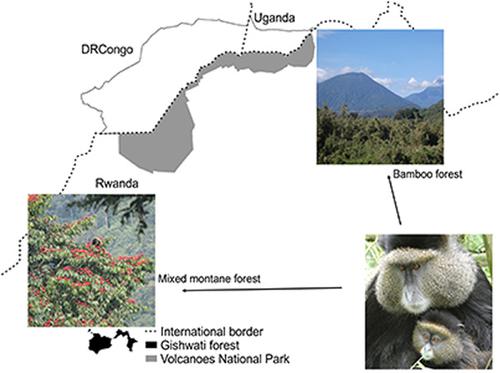当前位置:
X-MOL 学术
›
Am. J. Primatol.
›
论文详情
Our official English website, www.x-mol.net, welcomes your feedback! (Note: you will need to create a separate account there.)
High flexibility in diet and ranging patterns in two golden monkey (Cercopithecus mitis kandti) populations in Rwanda
American Journal of Primatology ( IF 2.4 ) Pub Date : 2021-11-23 , DOI: 10.1002/ajp.23347 Deogratias Tuyisingize 1, 2 , W Eckardt 1 , D Caillaud 3 , B A Kaplin 2, 4, 5
American Journal of Primatology ( IF 2.4 ) Pub Date : 2021-11-23 , DOI: 10.1002/ajp.23347 Deogratias Tuyisingize 1, 2 , W Eckardt 1 , D Caillaud 3 , B A Kaplin 2, 4, 5
Affiliation

|
Many primates exhibit behavioral flexibility which allows them to adapt to environmental change and different habitat types. The golden monkey (Cercopithecus mitis kandti) is a little-studied endangered primate subspecies endemic to the Virunga massif and the Gishwati forest in central Africa. In the Virunga massif, golden monkeys are mainly found in the bamboo forest, while in the Gishwati forest they live in mixed tropical montane forest. Here we describe and compare the diet of golden monkeys in both fragments. Over 24 consecutive months from January 2017 we used scan sampling to record feeding and ranging behavior of two Virunga groups and one Gishwati group totaling ca. 240 individuals. We also examined the phenology of bamboo and fruit trees, key seasonal food plant species for the monkeys. Golden monkeys fed on more than 100 plant species. The Virunga groups were mostly folivorous (between 72.8% and 87.16% of the diet) and fed mostly on young bamboo leaves and bamboo shoots, while 48.69% of the diet of the Gishwati group consisted of fruit from 22 different tree and shrub species. Bamboo shoots and fruit are seasonally available foods and were consumed regularly throughout the period when they were available. Despite being the smallest of the three study groups, the Gishwati group had a larger home range area (150.07 ha) compared to both Virunga groups (25.24 and 91.3 ha), likely driven by the differences in availability and distribution of fruit and bamboo in the habitats. Like other blue monkey subspecies, golden monkeys appear to have a flexible dietary strategy enabling them to adjust diet and ranging behavior to local habitats and available food resources. Additional studies and continuing conservation efforts are needed to better understand how variation in feeding and ranging ecology affects reproduction, population growth, and carrying capacity.
中文翻译:

卢旺达两个金丝猴 (Cercopithecus mitis kandti) 种群的饮食和分布模式的高度灵活性
许多灵长类动物表现出行为灵活性,这使它们能够适应环境变化和不同的栖息地类型。金丝猴 ( Cercopithecus mitis kandti) 是一种鲜为人知的濒临灭绝的灵长类亚种,是非洲中部维龙加地块和吉什瓦蒂森林特有的。在维龙加地块,金丝猴主要生活在竹林中,而在吉什瓦蒂森林中,它们生活在热带山地混交林中。在这里,我们在两个片段中描述和比较了金丝猴的饮食。从 2017 年 1 月起连续 24 个月,我们使用扫描采样来记录两个 Virunga 组和一个 Gishwati 组的摄食和测距行为,总计约 100 年。240人。我们还检查了竹子和果树的物候,它们是猴子的主要季节性食用植物。金丝猴以 100 多种植物为食。Virunga 组大多是叶食性的(占饮食的 72.8% 和 87.16% 之间),主要以嫩竹叶和竹笋为食,而 48. Gishwati 组 69% 的饮食由来自 22 种不同树木和灌木的水果组成。竹笋和水果是季节性食物,在它们可用的整个期间定期食用。尽管 Gishwati 组是三个研究组中最小的一个,但与 Virunga 组(25.24 和 91.3 公顷)相比,Gishwati 组的家庭范围更大(150.07 公顷),这可能是由于水果和竹子的供应和分布差异所致。栖息地。与其他蓝猴亚种一样,金丝猴似乎具有灵活的饮食策略,使它们能够根据当地栖息地和可用食物资源调整饮食和范围行为。需要更多的研究和持续的保护工作,以更好地了解摄食和分布生态的变化如何影响繁殖,
更新日期:2022-01-03
中文翻译:

卢旺达两个金丝猴 (Cercopithecus mitis kandti) 种群的饮食和分布模式的高度灵活性
许多灵长类动物表现出行为灵活性,这使它们能够适应环境变化和不同的栖息地类型。金丝猴 ( Cercopithecus mitis kandti) 是一种鲜为人知的濒临灭绝的灵长类亚种,是非洲中部维龙加地块和吉什瓦蒂森林特有的。在维龙加地块,金丝猴主要生活在竹林中,而在吉什瓦蒂森林中,它们生活在热带山地混交林中。在这里,我们在两个片段中描述和比较了金丝猴的饮食。从 2017 年 1 月起连续 24 个月,我们使用扫描采样来记录两个 Virunga 组和一个 Gishwati 组的摄食和测距行为,总计约 100 年。240人。我们还检查了竹子和果树的物候,它们是猴子的主要季节性食用植物。金丝猴以 100 多种植物为食。Virunga 组大多是叶食性的(占饮食的 72.8% 和 87.16% 之间),主要以嫩竹叶和竹笋为食,而 48. Gishwati 组 69% 的饮食由来自 22 种不同树木和灌木的水果组成。竹笋和水果是季节性食物,在它们可用的整个期间定期食用。尽管 Gishwati 组是三个研究组中最小的一个,但与 Virunga 组(25.24 和 91.3 公顷)相比,Gishwati 组的家庭范围更大(150.07 公顷),这可能是由于水果和竹子的供应和分布差异所致。栖息地。与其他蓝猴亚种一样,金丝猴似乎具有灵活的饮食策略,使它们能够根据当地栖息地和可用食物资源调整饮食和范围行为。需要更多的研究和持续的保护工作,以更好地了解摄食和分布生态的变化如何影响繁殖,



























 京公网安备 11010802027423号
京公网安备 11010802027423号